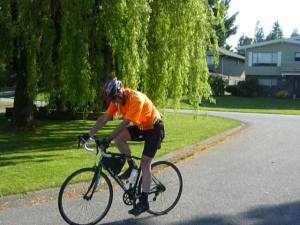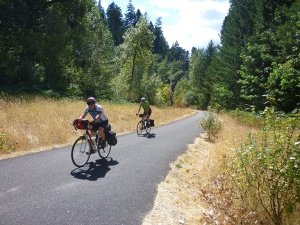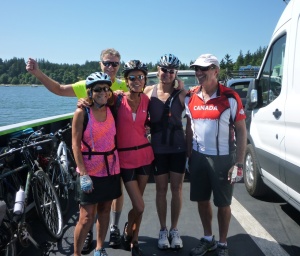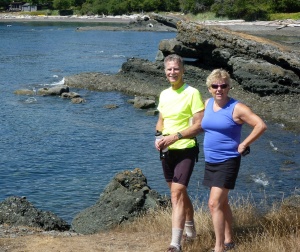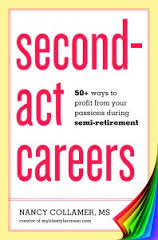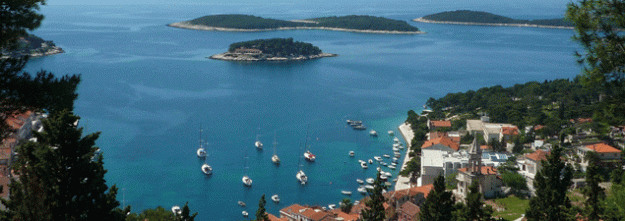“Pshaw!” said Cheryl. “They won’t blame you.” I wasn’t so sure.
Our long-awaited late-September boat and cycle trip through the southern Dalmatian Islands was to begin the next day. After two previous European cycle trips on our own, Cheryl and I had invited members of our outdoor club to join us in Croatia this year. We’d hoped for half a dozen. When the boat sold out 11 months ago, we had 17 in our group. Fantastic.

The southern Dalmatian Islands at dusk as seen from Srđ above Dubrovnik.
Or was it? What if the trip wasn’t what we’d advertised to our friends? A mismanaged trip, or even a bad guide, and our names could be mud. The weather was threatening as well. We’d arrived in Dubrovnik a few days earlier only to wade through an unseasonal deluge that one fellow-traveler described as “biblical.”

This storm over the Dalmatian Islands later deluged Dubrovnik, turning the stairs to cataracts.
We were also a nervous about the hills. This had been the biggest single topic of discussion among our group during the planning stages. While most of us were cyclists, we did range from late 50s to early 70s, so it made sense to be prepared. Like many in our group, Cheryl and I made sure to get several trips under our belt over the summer in the islands near our home – but they averaged less than half the heights we were expecting here.

Before heading for the ship, Cheryl and I enjoy a final view from the deck of our Airbnb digs.
Departure day dawned with bright sunshine. Arriving at the Port of Gruž by bus, Cheryl and I were buoyed when we spotted the elegant and modern yacht, the Harmonia, with more than 30 bicycles arrayed out in front of her on the dock. It was time to meet our two guides, the crew of six, and our 30 fellow-travelers. Besides our own group members, arriving in Dubrovnik on various itineraries, there were another 15 from other parties.

Along with a fellow-rider, Cheryl inspects the bicycles.
Of the 32 passengers, there was one American, a few each from Australia, New Zealand, and Denmark – and the rest were Canadian. On the previous week’s sailing, the majority had been German-speaking. The crew and the ride-leader guides were from various parts of Croatia, and like many Croatians we met, they all spoke excellent English. A good thing, as we found Croatian impenetrable.
Cheryl and I unpacked in our air-conditioned stateroom, which was bigger and better equipped than some hotel rooms we’ve been in. After that, our guides, Petra and Neven, introduced us to our bikes. While many in our group had brought their own pedals or seats, Cheryl and I decided we would live with whatever we got. After a few test rides around the dock, we were all satisfied: comfortable, easy-shifting, almost new, and well-maintained. Two of our group and a few of the others had elected to reserve e-bikes, and they were promised a complete lesson before the first ride.

Spending a few days in Dubrovnik is well worth it. Try to avoid the crowds.
Our first formal activity was a tour of Dubrovnik with a professional guide. For some on the ship, this was their first visit to the city. Even though others of us had already spent two or three days here, we saw new parts of town and learned more of its thousand-year history. After some free time in town, we enjoyed the first of many tasty shipboard dinners featuring Croatian seafood and other specialties. The first evening also included wine and schnapps on the captain. “Živjeli!”

Captain Josip at the helm of the Harmonia.
The follow morning Captain Josip set course across an incredibly azure Adriatic towards the first of our island destinations, Šipan. This was our test ride: fairly level and about 45 minutes each way from the harbour to the small town of Suđurađ. Everyone would have a chance to iron out any kinks in their bicycles … or legs.
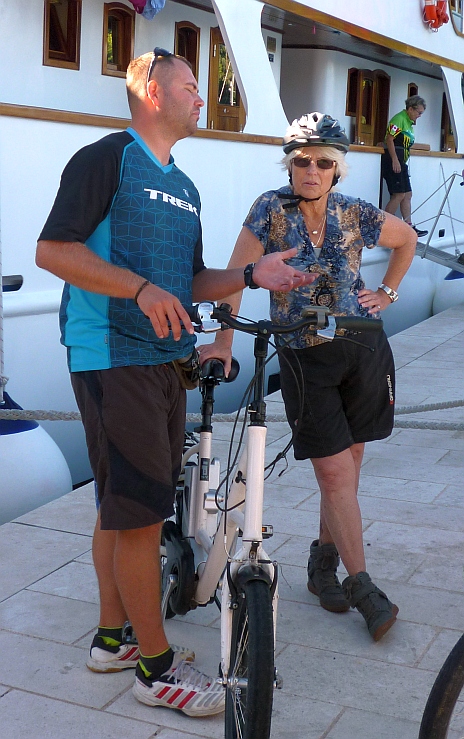
Neven gives a rider a lesson on the ebike.
The promise of this ride was encouraging. The bikes performed well. The roads were quiet, and with a few exceptions, well signed and in good repair. Just in case, our guides had provided each of us with maps of the island, with our route hand-traced. Along the way, we passed vineyards and other crops, fascinating churches or occasional ruins, and figs and other fruit growing along the roadside. The quiet coffee stop at the picturesque waterfront town of Suđurađ was an excellent introduction to the many small island villages we would be visiting over the week to come. As we dug into our hot lunch back on the Harmonia, we got under way to our next destination.

Our first kava stop at Suđurađ, on the island of Šipan
About the only thing that had been missing from the Šipan ride were panoramic vistas. On Mljet, that would be remedied. We would pay for it in lengthy hill climbs and “undulating” roads, making it the “hardest ride of the week.” That turned out to be smart strategy on the part of the organizers, although some of the e-bike riders who hadn’t quite got the hang of their rides elected to sun themselves on the Harmonia as she sailed the length of the island to meet us. For the rest of us, as we contemplated the island summits each morning, we could always say, “Well, it can’t be as hard as Mljet!”

Starting up the first hill on Mljet, above Sobra. Why are we leaving this idyllic spot?
The crew and the guides on these trips work long hours and hard. Yet somehow they manage to remain up-beat and friendly all the while. Besides three hot meals a day and the on-demand bar, great Croatian coffee was always ready before seven, and the last drinks were served after 10 pm. Once and often twice a day, the entire stock of 35 bikes had to be unloaded from the hold and readied for the next ride. (Those e-bikes are heavy.) There was always something interesting for us to do while the staff worked.

Even a boathouse for a PT boat sports that azure water
Before our ride on Lastovo, some of us toured decaying Cold War era tunnels on the small connected island of Prežba, until recently an off-limits military base. Others kayaked lazily around the bay, or sunned themselves top side, while taking in the spectacular scenery.

Succulents line this waterfront road on Lastovo.
On Lastovo, we had another glimpse of the challenging job of ride leaders. As fifteen of us are in the same outdoor association, many of us have had experience leading bike trips of from ten to thirty individuals. We know how challenging it can be to provide suitable guidance, watch out for road safety, and still allow riders to set their own pace and enjoy the ride. When we arrived at the town of Lastovo, it came out during coffee and beer, that one of the riders had continued through town and not returned. His companions had become concerned when he didn’t show up, mentioning that he was “getting on in years.” Petra and Neven managed to spend a couple of hours searching the far end of the island, while coordinating others of us to help, and the rest to get back safely to the Harmonia. In the end, the wayward rider showed up unassisted at the ship, having spent a couple of hours drinking beer and discussing wines with a local farmer in his barn. All in a day’s work for our hard-working guides.

In Lastovo, each chimney is different, and reflected the home’s social status
There was a little bonus from the adventure. While Cheryl and I were out searching Lastovo with a friend of the missing man, we stumbled upon a tiny home-based winery, and were invited in for sampling and a mini-tour. Our companion was happy to buy a very inexpensive bottle of a very local wine. By policy, the tour company does not do winery stops in order to avoid dangerous afternoon riding conditions.

Two of our club members approach the summit of Korčula.
Our next trip was the first of two across the island of Korčula. Although the rides on Korčula were not as long as Mljet, they included some of the biggest hills of the week. A couple of them were more than five kilometers of uninterrupted climb, although never more than a 10 percent grade, and more often six to eight. Not impossible, but definitely a challenge if you aren’t used to hill climbing. Our club members all made it, but some of the other passengers sometimes pushed their rides, or made use of the e-bikes (which often meant they led the pack.) On most days, the guide who was “sweep” at the end of the group would start out with an e-bike so that they could swap if someone tired on their regular bicycle. This was not advertised, but it really showed the effort taken by Petra and Neven to ensure the trip worked for everyone.

How could you resist a swim in the beautiful anchorage at Prigradica
Hey, did I mention the swimming? Most days, there were one or two opportunities for swimming off shower-equipped back of the Harmonia. It was impossible to resist. The water was stunningly clear, and that distinctive azure blue that characterizes the Adriatic in this area. It was also warm enough to get in and stay in. That despite the late September date following the “worse summer in decades.”

The water’s great at Prigradica on Korčula
After three days of hilly cycling, some of us were glad of a day off for a side trip to Mostar in neighbouring Bosnia and Herzegovina. Others might have preferred not to break up the rhythm of the cycling. On the one hand, it was a two-hour bus ride each way, with lengthy stops at both Croatian and Bosnian customs in both directions. Mostar was hot, and rather overrun with tourists. On the other hand, it’s an iconic place, in terms of both its ancient and recent history.

A quiet moment in one of the mosques in Mostar
Our guide, Senad, was interesting and informed, and I found it engaging to discuss with him some of the aspects of the recent ethnic conflict, together with his hopes for the future. With a little effort, we were able to visit places with fewer tourists, such as the interiors of some of the mosques that dot the city. In the quieter spaces, one could reflect on the significance of the cross upon the hill, or the war-damaged buildings. We could appreciate our return to our peaceful port that evening. “Mi smo tako sretni!” We are so lucky!
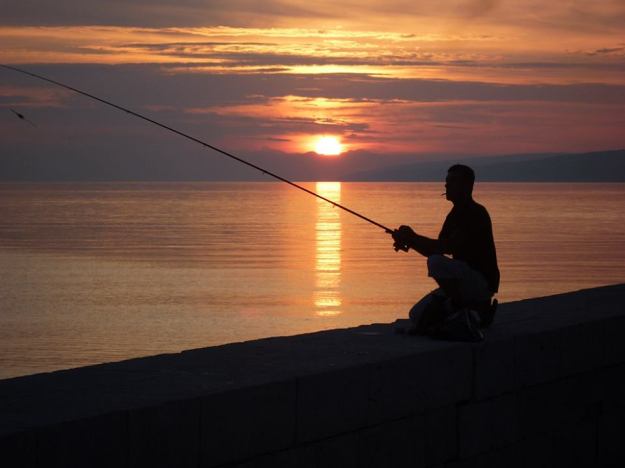
A peaceful evening in Gradac on the Makarska Rivijera
The entire tour had a satisfying cultural component. In addition to Dubrovnik and Mostar, we also had a professional guide in the old town of Korčula. For all the other islands and towns we visited, Petra gave an interesting historical or cultural presentation somewhere along the way. Although I’m sure she was well-versed in Croatian culture, it was obvious she put a lot of preparation into her job. Often, the guides went beyond the strict requirements of the job description. One morning, a half-hour Croatian language lesson lasted for 90 minutes; we were such eager students, she said.

“Good Morning!” While under way, Petra (wearing her Croatian flag skirt) leads us in a class in Croatian.
One evening, as a special treat, Petra spent several hours giving us her personal view of some of the challenges of life in Croatia. The country suffered considerably during the multi-year war that followed its declaration of independence in 1991. Many industries have yet to recover, and the very personal scars of the war run deep. The country was hit hard again in the global crisis of 2008. Unemployment currently sits at over 17%, and the average gross income is less than $18000 per year. Petra had spent several years working as a nanny in the UK and the US before returning to the country she loved. As an independent guide in a seasonal industry, staying employed was always a challenge. Yet, she also knew that she was better off than many of her compatriots who would have to leave Croatia to find work. Croatia’s recent EU membership was not embraced by everyone. There have been some losers.

Like Croatia, Bosnia suffered horribly during its war for independence (photo taken near the bridge at Mostar)
It was an engaging evening, and we definitely appreciated Petra’s frank and sometimes emotional delivery. We felt we were getting more than just the canned tourist spiel, and were grateful for it. Perhaps in return, we all opened up a bit more. On this trip, I learned things from some long-time friends that I’d never heard before.

Cycling hundreds of meters above the bay at Pupnatska Luka on Korčula
Back on Korčula again for one of the longer rides, the hills no longer seemed so forbidding. They were just part of the journey, and we knew that each one led to views more stunning than the previous. At the end of the longest climb, it was a cool delight to encounter a roadside fruit stand, where we quickly demolished more than one juicy watermelon. Riding along the seaside into Korčula town that evening, I felt a little sad knowing we had only one more day of riding.

A leisurely sea-side ride into Korčula town
That last day, for the first time all week, we woke to gray skies and whitecaps on the water. Given all we’d heard about the eastern Adriatic’s “year without a summer,” we thought ourselves lucky to have enjoyed the past six days of blue skies and sun on our shoulders. Our final day of riding took us through the old town of Ston, a salt-drying region since Roman times. The surrounding countryside is protected by a huge wall, second only to the Great Wall of China. Leaving Ston, we had to make a decision on whether to climb the final hill, which, on clear days, would offer “the most spectacular view yet.” Just then, the sky darkened and we heard the rumbling of an approaching storm. Our guides explained that coming down the hill could be dangerous in the rain, and advised that we might do better taking a shortcut down the Split-Dubrovnik highway. What to do?

Thunder rolls ominously overhead as we decide to avoid the final hilltop climb
We broke up into groups of three or four, and cycled down the paved shoulder at two-minute intervals. It was busy, although not as harrowing as I’d expected. In the end, it was almost certainly the better option. The storm broke just as we reached the ship. Had we gone over the hill, we would have found ourselves right at the top just when the deluge hit. Although riding in traffic is something I try to avoid, the last half hour in traffic reminded me that, for the entire rest of the week, we’d had the roads almost to ourselves. We often rode for an hour or more without seeing a single car. I even wondered why they kept such well-maintained roads for so little traffic. Whatever the reason, this was one of the best weeks of cycling I’ve ever enjoyed.

A rider demonstrates her e-bike on one of the many quiet back roads
I needn’t have worried about letting our group down. Comments ranged from “awesome” to “best trip ever!” September is a great month for riding here, and the best month for swimming. Apparently, this is true even in an off year. This was a well-organized tour; the crew and guides were personable and highly professional. A beautiful part of the world, with history stretching back for millennia, the southern Dalmatian islands are a great place to swim, boat, and cycle. Or just to sit in the sun, watch the world go by, and enjoy a coffee, beer, or ice cream – national favourites, all. Some of us will be back.

“This trip was awesome! When’s the next one?” (aboard the Harmonia)
Related Posts
If you want to follow in our tracks:
The tour company is Island Hopping, based in Germany. They operate similar tours in Croatia, Montenegro, Greece, Turkey, and Vietnam. Others in our club have been on a number of these; all reported great trips. Their organized approach is evident. As with our Dalmatian trip, Island Hopping charters local ships and crews, and contracts independent ride leaders and guides. Their tour list sounds like our bucket list.

Harmonia and friend await us for lunch and a swim
We booked this trip through BikeTours.com (formerly Bike Tours Direct.) This is the second trip we’ve booked through them. You pay the same rate whether booking directly or through BikeTours.com, but we have done well going through a company we know, and in our time zone. The small team at BikeTours.com are all riders themselves – sometimes they’re spread a little thin when they’re out reviewing rides, but that’s the good news. They know a lot about the tours they sell. Simon & Richie did an excellent job of helping us coordinate the plans of 17 riders. (That may warrant a post of its own!) We look forward to dealing with them again. Meanwhile, here’s the tour: “Dalmatia from Dubrovnik”

At the top, a placque commemorates the defence of Korčula from a Turkish attack in 1571.


